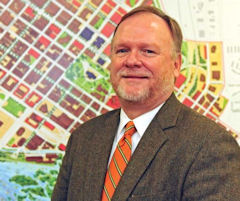by James A. Bacon
According to growth projections cited by the Urban Land Institute, the population of the Richmond region is expected to grow by roughly 200,000 households (430,000 people) by 2035. Where will that growth go? How much of it can be absorbed by existing urban areas, and how much will end up, by default, as sprawl-like development in outlying jurisdictions?
Mark Olinger, planning director for the City of Richmond, says the city could grow to a population of 250,000 over the next two decades — an addition of roughly 40,000 residents. The resulting investment has the potential to transform the city, he says. “Richmond can be one of the great midsized cities in America.”
The city population peaked around 1970 at 250,000 residents. But households were larger then than they are today; more people packed into houses and apartments than they do now. Today’s population contains more singles, more empty nesters and more single-parent households. Therefore, a population of 250,000 today will require considerably more housing units. Where will those units go?
Some neighborhoods will see very little change, Olinger told me last week during lunch at Comfort, a downtown restaurant. The residents of Windsor Farms, a neighborhood of million-dollar homes, like things exactly the way they are. The same can be said of historic neighborhoods like the Fan, Church Hill and Ginter Park. But there’s plenty of under-utilized land in the old Manchester district, south of the James River from downtown, Scott’s Addition, an old industrial zone off Interstate 64, and along the old federal highway corridors like Broad Street, Midlothian Turnpike and U.S. 1.
Those areas can be re-developed with mixed-use buildings at much higher residential densities. Because those areas are zoned for commercial and industrial, they need not inpinge upon single-family dwellings where homeowners want to preserve the character of their neighborhoods. With greater density, such corridors also can be served by Bus Rapid Transit (see “Will Broad Street BRT Pay Its Own Way?“), which would ease traffic congestion.
Before coming to Richmond in 2011, Olinger served as planning director of Madison, Wisc., which, like Richmond, is a state capital with a large university downtown. Many of the challenges are the same, including the fact that roughly half the real estate — owned by the state and local government, churches and universities — is tax exempt.
Olinger also shares Mayor Dwight Jones’ vision of re-developing Richmond’s crime-ridden housing projects as mixed-use communities that bring jobs into the city’s poorest neighborhoods and, as a bonus, bust up the concentrations of poverty associated with crime and other social pathologies.
Though optimistic, Olinger does not understate the challenges. “People talk about infill as if all the infrastructure is in place,” he says. “Yeah, we may have sewers but they’re 100-year-old sewers.” Creating the kind of walkable, bikable streetscapes that Olinger would like also costs money.
The good news is that S&P has just upgraded the city’s bond rating to AA+, giving Richmond cheaper access to capital than, say, Washington, D.C., Baltimore, New York or Los Angeles. But the city still falls short of the AAA rating commanded by the likes of Charlotte, Minneapolis and Columbus. And to maintain the rating, Richmond must stick to strict debt management policies that limit debt to 10% of total budgeted expenditures and 4.5% of total taxable assessed real estate values. Capital spending financed by the General Fund (not including utilities) was $112 million for Fiscal Year 2013 but will fall to $41 million by FY 2017.
Another challenge is making the city a desirable destination for families with school-age children. Home builders are creating plenty of product for singles and empty nesters but not much that’s suitable for traditional nuclear families.
Still, says Olinger, the city has great architecture and a great scale. “It’s got good bones. If the bones are good, there’s always the chance that people will come back.”



